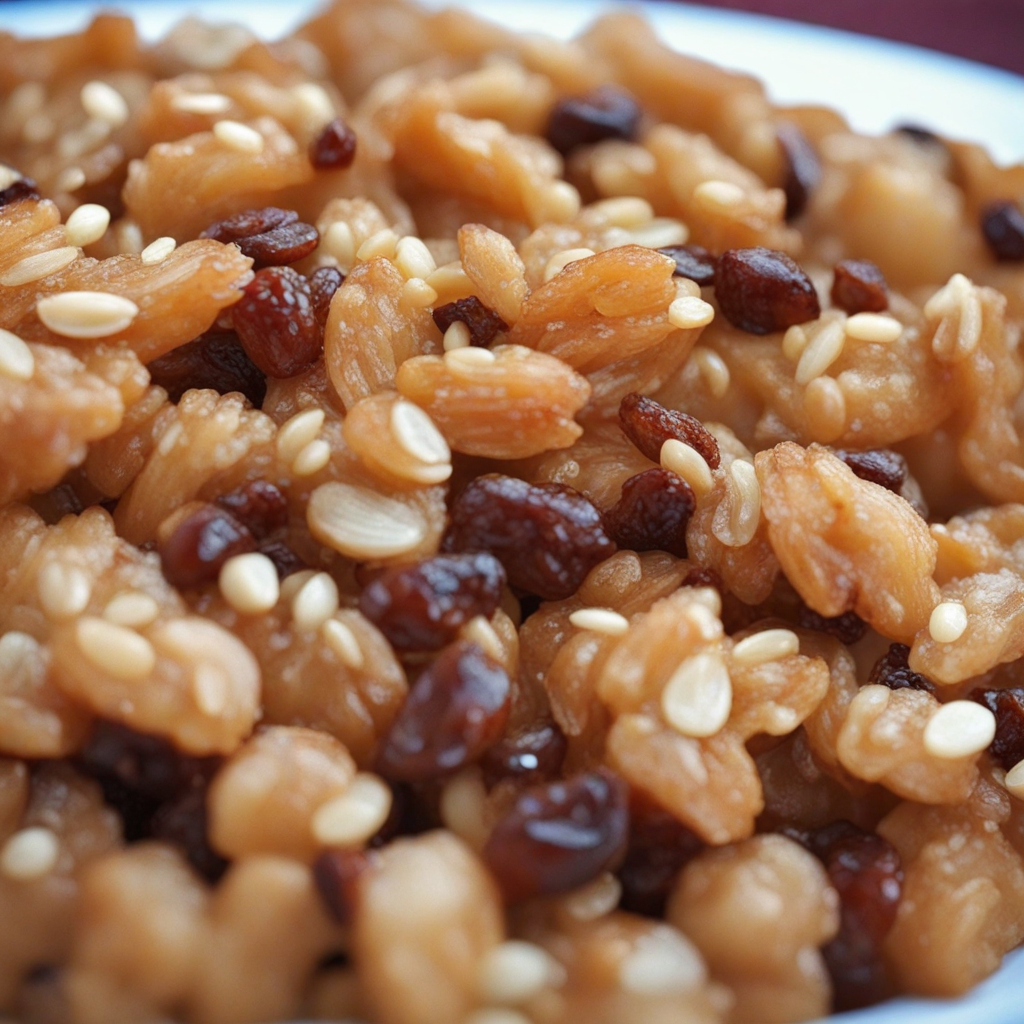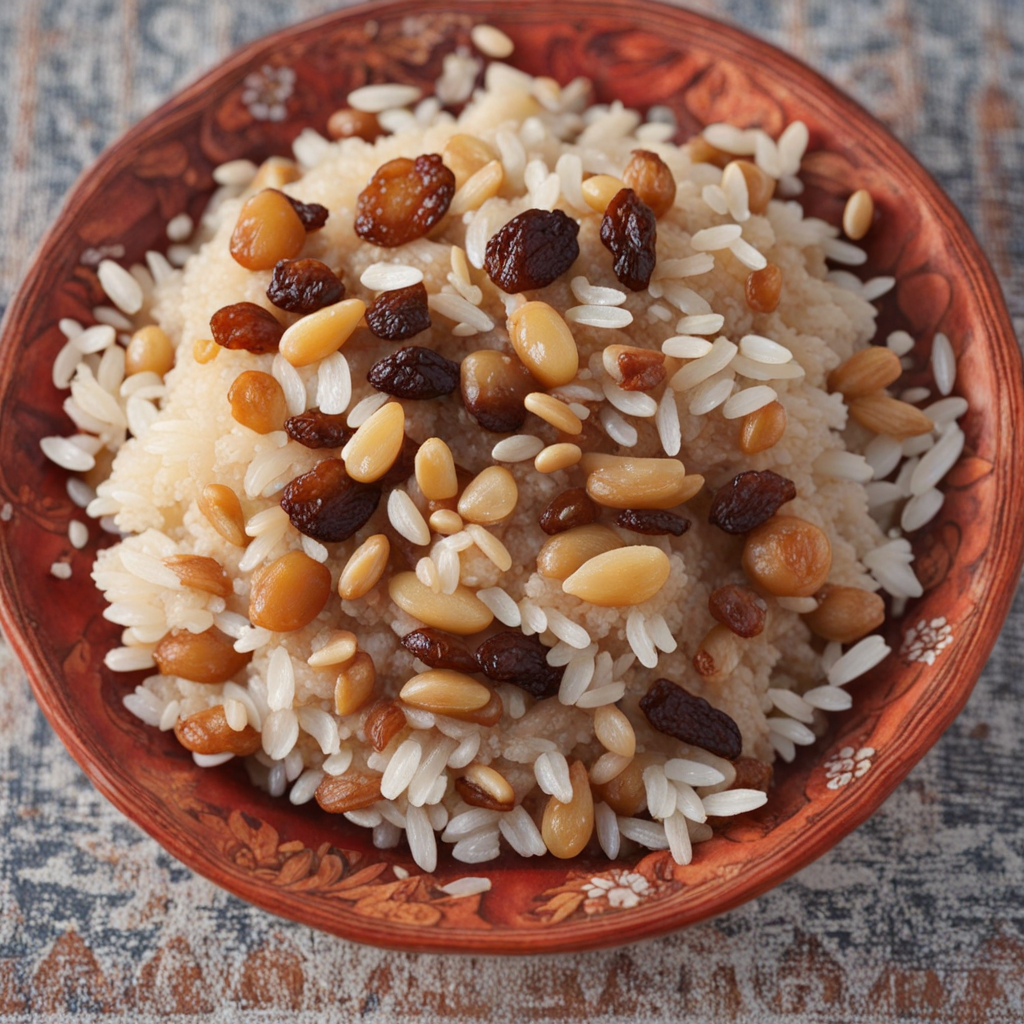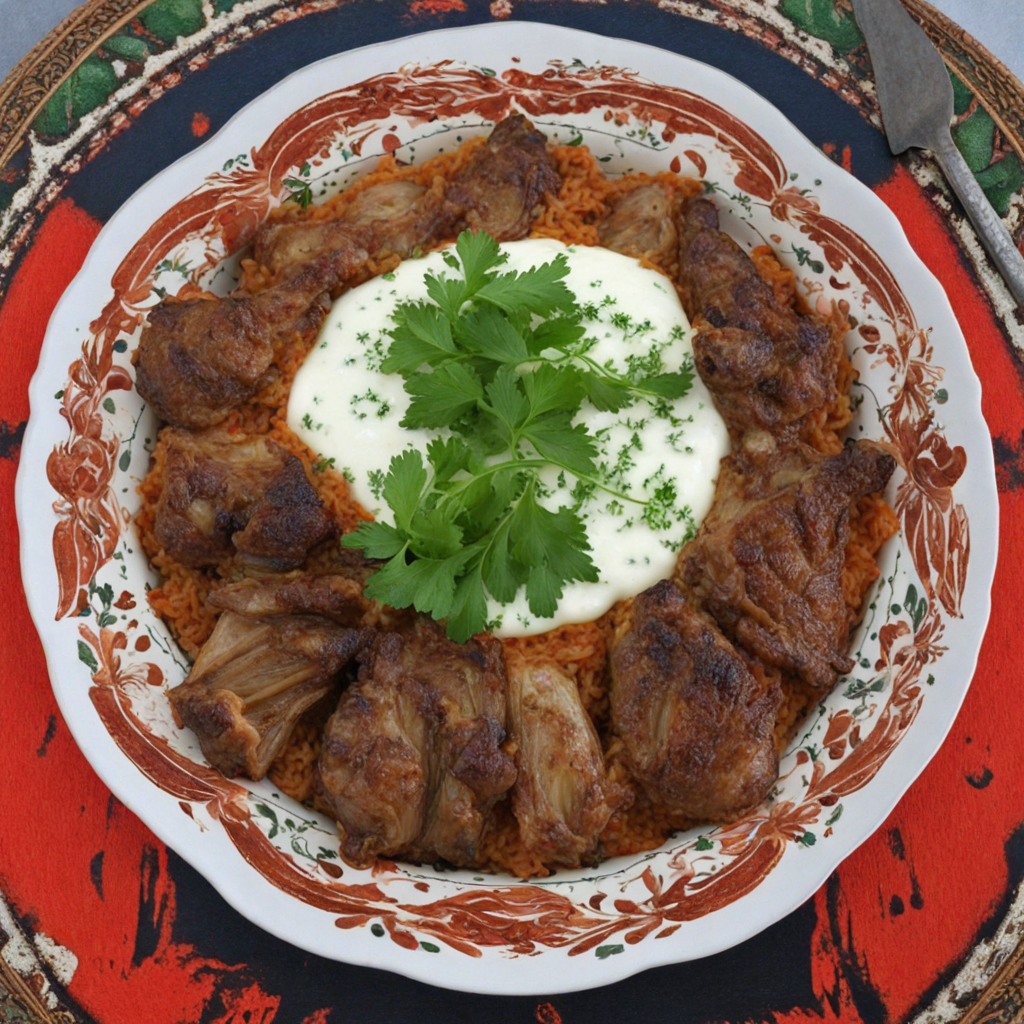Kabuni
Kabuni is a traditional Albanian dish that beautifully showcases the region's rich culinary heritage. At its core, Kabuni is a fragrant rice dish, often prepared with a blend of aromatic spices that elevate its flavor profile. The rice is typically cooked in a savory broth infused with ingredients such as onions, garlic, and a medley of spices, including cinnamon and cardamom, which lend a warm, inviting aroma. The dish is often adorned with tender pieces of meat, commonly chicken or lamb, which soak up the essence of the spices, creating a harmonious blend of flavors that is both comforting and satisfying. The dish is characterized by its unique preparation method, where the rice is layered with meat, spices, and sometimes dried fruits such as raisins or apricots, adding a subtle sweetness that balances the savory components. This layering technique allows the flavors to meld together beautifully, resulting in a dish that is both visually appealing and rich in taste. The rice is typically cooked until fluffy, with each grain distinct, creating an inviting texture that complements the tender meat and aromatic spices. Served hot, Kabuni is often accompanied by a side of tangy yogurt or a fresh salad, which adds a refreshing contrast to the rich flavors of the dish. It is a meal that not only satisfies the palate but also evokes a sense of warmth and tradition, making it a perfect choice for family gatherings or special occasions. For those looking to explore a new taste, Kabuni offers a delightful journey into Albanian cuisine, inviting you to savor the unique blend of spices and the heartwarming essence of its cultural roots.
How It Became This Dish
The History of Kabuni: A Culinary Gem of Albania Introduction Kabuni, a traditional dish from Albania, encapsulates the rich tapestry of the country’s culinary heritage. This aromatic rice dish, often associated with festive occasions, marries the flavors of sweet and savory, reflecting the complex historical influences that have shaped Albanian cuisine over centuries. In this exploration, we will delve into the origins of Kabuni, its cultural significance, and its evolution through time, painting a vivid picture of this beloved dish. Origins of Kabuni The origins of Kabuni can be traced back to the medieval period in the Balkans, influenced by a myriad of cultures that have traversed this region. The dish is primarily composed of rice, which is a staple in many Albanian households, and is typically prepared with a combination of spices, caramelized onions, and meat, often chicken or lamb. However, it is the unique addition of sweet elements, such as raisins or dried fruits, that sets Kabuni apart from other rice dishes in the region. The etymology of the word "Kabuni" is believed to derive from the Arabic word "kabun," referring to a dish that is cooked slowly and often incorporates spices and fruits. The introduction of rice to the Balkans is thought to have occurred during the Ottoman Empire's expansion, which lasted from the late 14th century until the early 20th century. The Ottomans were known for their elaborate culinary traditions, and rice pilafs became a staple of their cuisine, leading to the creation of various regional adaptations across the empire, including Kabuni in Albania. Cultural Significance Kabuni holds a special place in Albanian culture, often featured during significant events and celebrations. It is particularly popular during weddings, religious holidays, and family gatherings, symbolizing abundance and hospitality. The preparation of Kabuni is often a communal activity, where family members come together to share in the cooking process, reinforcing social bonds and cultural traditions. The dish is not merely sustenance; it embodies a sense of identity and continuity within the Albanian community. Kabuni’s sweet-savory flavor profile represents the duality of life — joy and sorrow, celebration and remembrance. Its presence at important life events signifies the importance of family and community in Albanian culture. The act of serving Kabuni to guests is a gesture of respect and generosity, aligning with the traditional Albanian value of "besa," or hospitality. Development Over Time As Albania transitioned through various socio-political landscapes, Kabuni also evolved. During the Ottoman period, the dish became more refined, with the introduction of new spices and cooking techniques. The use of saffron, for example, became popular, imparting a distinctive color and flavor that enhanced the dish's appeal. The incorporation of nuts, particularly almonds and walnuts, added texture and richness, further elevating Kabuni’s status as a festive dish. The 20th century brought significant changes to Albania, particularly during the communist regime that lasted from World War II until the early 1990s. The restrictive policies led to a simplification of traditional recipes, as access to ingredients became limited. Many families adapted Kabuni to use locally available components, resulting in regional variations that reflected the resources at hand. Despite these challenges, the essence of Kabuni remained intact, serving as a reminder of the country’s culinary legacy. With the fall of communism and the subsequent opening of Albania to the world, there has been a revival of traditional dishes, including Kabuni. Chefs and home cooks alike have sought to reconnect with their culinary roots, experimenting with flavors and techniques while honoring the dish’s historical significance. Contemporary interpretations of Kabuni often include modern twists, such as the addition of fresh herbs or innovative garnishes, while still preserving its core identity. Kabuni Today In modern Albania, Kabuni continues to be a cherished dish that bridges generations. It is commonly found in restaurants and is often featured in culinary festivals that celebrate Albanian heritage. The dish has also gained attention from food enthusiasts and tourists seeking an authentic experience of Albanian cuisine. As globalization influences eating habits and culinary styles, Kabuni stands resilient, representing both tradition and adaptation. Today, the preparation of Kabuni often involves a blend of traditional methods and contemporary culinary practices. Home cooks may experiment with different types of rice, such as basmati or jasmine, or incorporate seasonal vegetables to enhance the dish's nutritional value. Additionally, the rise of social media has led to a resurgence in interest in traditional recipes, with many food bloggers and influencers sharing their takes on Kabuni, thus broadening its appeal beyond Albania. Conclusion Kabuni is more than just a dish; it is a narrative of Albania's history, culture, and resilience. From its origins rooted in the Ottoman culinary legacy to its modern interpretations that celebrate Albanian identity, Kabuni embodies the spirit of a nation that values community, tradition, and the joy of sharing a meal. As Albania continues to forge its path in the global culinary landscape, Kabuni remains a symbol of its rich heritage, inviting all to partake in a taste of its storied past. The flavors of Kabuni are a testament to the enduring connection between food and culture, reminding us that every dish has a story to tell, and in the case of Kabuni, it is a tale worth savoring.
You may like
Discover local flavors from Albania







